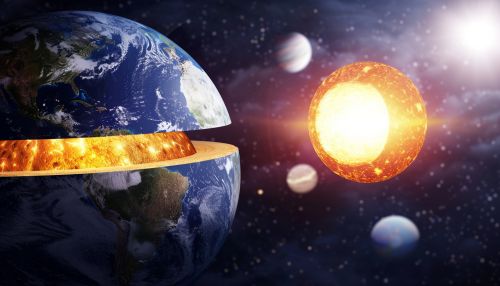Outer core
Composition
The outer core, one of the three main layers of the Earth, is a fluid layer approximately 2,200 kilometers (1,367 miles) thick and lies beneath the mantle and above the inner core. It is predominantly composed of liquid iron and nickel. This layer is unique among Earth's layers as it is the only layer that is in a fluid state.


The outer core is vital to Earth's magnetic field. The flow of liquid iron within this layer generates electric currents, which in turn produce magnetic fields. This geodynamo effect results in Earth's magnetosphere, which protects the planet from harmful solar radiation.
Physical Properties
The outer core's temperature ranges from 4400 °C in the outer regions to 6100 °C near the inner core. As a result of these extreme temperatures, the outer core exists in a low viscosity fluid state despite the high pressures. The pressure in the outer core ranges from 1.3 million (at the top of the outer core) to 3.3 million atmospheres (at the boundary of the inner core).
The outer core is denser than the mantle but less dense than the inner core. The density of the outer core ranges from 9.9 g/cm³ at the top to 12.2 g/cm³ at the bottom. This increase in density with depth is due to the increase in pressure and the change in composition.
Chemical Composition
The outer core is believed to be composed primarily of iron and nickel, similar to the inner core. However, the outer core also contains lighter elements such as oxygen, sulfur, and silicon. These lighter elements are believed to be the result of chemical reactions between the core and the mantle.
The exact composition of the outer core is still a subject of ongoing research. It is challenging to study directly due to its extreme conditions and inaccessibility. Most of what we know about the outer core comes from studying seismic waves and from laboratory experiments that simulate the conditions in the outer core.
Role in Earth's Magnetic Field
The outer core plays a crucial role in generating Earth's magnetic field. This process, known as the geodynamo, occurs as the Earth rotates and the liquid iron within the outer core moves in a rotational pattern. This movement generates electric currents, which in turn create magnetic fields. The combined effect of these magnetic fields forms the Earth's magnetosphere.
The magnetosphere protects the Earth from harmful solar radiation. Without the magnetosphere, life as we know it would not be possible on Earth. The magnetosphere also plays a role in creating phenomena such as the aurora borealis and aurora australis.
Exploration and Study
The outer core is challenging to study directly due to its extreme conditions and inaccessibility. As a result, scientists rely on indirect methods to study this layer of the Earth. These methods include studying seismic waves, conducting laboratory experiments, and using computer models.
Seismic waves, specifically P-waves and S-waves, provide valuable information about the outer core. When these waves pass through the Earth, they change speed and direction depending on the type of material they encounter. By studying these changes, scientists can infer information about the composition and state of the outer core.
Laboratory experiments also provide insights into the outer core. Scientists can recreate the conditions of the outer core in a laboratory setting and study how materials behave under these conditions. These experiments help scientists understand the physical and chemical properties of the outer core.
Computer models are another tool used to study the outer core. These models simulate the conditions in the outer core and the dynamics of the geodynamo. By studying these models, scientists can gain insights into the processes occurring within the outer core and how they contribute to Earth's magnetic field.
